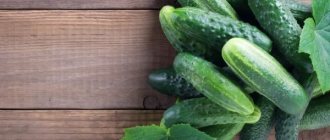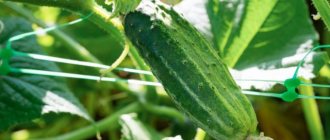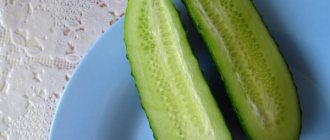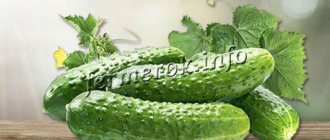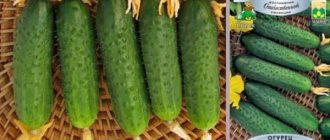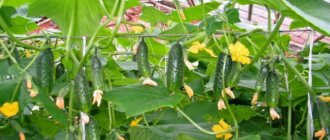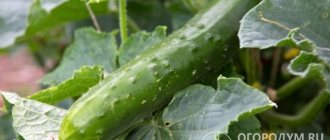It's hard to imagine a salad without cucumbers, especially in the summer. Almost all of us use them in one form or another, pickle them, preserve them, treat them to family and friends, and grow them for sale. Even in ancient times, Christopher Columbus added cucumbers to the diet of sailors to protect them from scurvy, and the famous Egyptian queen Cleopatra said that she owed her beauty to them.
The cucumber is popular not only in cooking - it also occupies a leading place in breeding work. With his participation, new varieties and hybrids are constantly being created. The advantage of the latter is that they combine the best qualities taken from the parent varieties. One of these hybrids is Paratunka F1, which has been among the sales leaders for several years. Let's get to know him better.
Description of cucumbers
The Paratunka F1 hybrid was created in 2006 based on the popular Parus variety and is supplied by the Russian company. It has good yield and is not particularly demanding on growing conditions.
Distinctive features
The hybrid is suitable for cultivation in summer cottages and for industrial production in farm cucumber plantations.
Paratunka produces a large harvest when grown both on trellises and on the ground . Moreover, the lashes quickly begin to take root on the soil. Vegetable growers have long noticed this distinctive feature and use it to strengthen the root system of the plant, which in cucumbers, especially hybrid ones, is traditionally weak and susceptible to disease.
Composition and properties
Like most of its fellows, the Paratunka cucumber consists of 95% water . The fruit has almost no voids and has few seeds.
Nutritional value of the product (per 100 g):
- calorie content - 14 kcal;
- proteins – 0.8 g;
- fat – 0.1 g;
- carbohydrates – 2.5 g;
- organic acids – 0.1 g;
- fiber – 1 g;
- glycemic index – 25.
In addition, the culture is rich in vitamins C and K, groups A and B. The fruit contains minerals such as iron, copper, manganese and many others. Cucumbers also contain iodine, which prevents thyroid diseases.
Regular consumption of fresh cucumbers can help remove small stones and sand from the kidneys and improve intestinal motility. But the vegetable is contraindicated in the diet if the stones in the kidneys and bile ducts are large.
Eating fruits accelerates the removal of fluid from the body, which lowers blood pressure, so hypotensive patients should use cucumbers with caution.
Characteristics of the Paratunka hybrid
The plant is medium tall, medium bushy . With good care, bushes can stretch up to 3 m in length.
The leaves are dense, light green or dark in color, medium in size. The hybrid does not require pollination; it is parthenocarpic, that is, only female flowers grow on the bushes.
Paratunka is an early ripening hybrid. The first fruits are harvested approximately a month after germination. Fruiting continues until the first frost, almost the entire season.
The fruits grow about 9 cm long and up to 3 cm in diameter . The color of the skin of cucumbers is dark green, the weight of a cucumber is on average 100 g. The fruits have a few tubercles and pronounced spines, have a characteristic cucumber aroma, and the flesh is crisp. The taste of these cucumbers has a sweetish tint.
Productivity with proper care is 15–17 kg per 1 sq. m.
The PARATUNKA cucumber is a very prolific and unpretentious plant.
Dubrovsky F1
This hybrid variety is reminiscent of the Paratunka F1 cucumber in its qualities, reviews from gardeners and farmers note this.
Dubrovsky F1 is an early ripening variety; it can be sown for seedlings already in mid-April, and transplanted into open soil by the end of May. If you sow it with seeds, it is better to do this in mid-May, in colder climates - in early June.
The Dubrovsky F1 cucumber produces its first harvest on days 40-44 at most. The fruits reach a length of up to 13 cm and are dense, which facilitates their long-term storage and the possibility of transportation over long distances.
The type of ovary is bouquet, in which 3-4 cylindrical cucumbers are formed at once. One bush produces up to 7 kg of fruit, so you can calculate the required number of seedlings in advance. This hybrid tolerates temperature changes well and is cold-resistant.
How to grow your own
The Paratunka hybrid is easy to grow even for an inexperienced gardener - using seeds or through seedlings.
Other hybrids for your site:
Early maturing hybrid "Bettina" for greenhouses and open ground
Hybrid "Uhazher" for growing in unfavorable conditions
Hybrid "Emelya": advantages and disadvantages, care features
Planting by seeds and seedlings
Planting and caring for the Paratunka hybrid is not much different from growing other varieties of cucumbers.
In most regions of our country, crop seeds are planted in open ground in the first ten days of May . You can use both germinated and dry planting material. To germinate the seeds, simply wrap them in damp gauze. Within a few days, sprouts will appear.
In the beds, the distance between planting holes should be at least 25 cm, between rows - up to 75 cm. Per 1 sq. m usually plant 3-4 plants.
The depth of the holes is 2 cm. Before planting the seeds, you should water the ground with hot water. Usually 2-3 seeds are placed in one hole, sprinkled with earth on top and lightly sprayed with warm, settled water. When shoots appear, one sprout is left, the most viable and strong, while the rest are removed.
Attention! Before seedlings emerge, the beds are covered with film to create a greenhouse effect.
It is better to prepare the bed in the fall by fertilizing the soil with mullein or chicken droppings.
According to the creators of the Paratunka F1 hybrid, it was originally intended only for greenhouses. But later it turned out that the plant grows well in open ground, and the crop ripens faster if planted through seedlings.
To obtain seedlings, the seeds are disinfected , soaked and planted in separate plastic or peat cups. The root system of the hybrid is weak, especially the upper roots, so Paratunka does not tolerate picking well.
Peat tablets, leaf humus and garden soil are used as soil . It is recommended to place drainage or sawdust at the bottom of the pots. Planting in open ground occurs after the formation of the fourth leaf.
Important! It is not recommended to violate planting deadlines. If you plant seedlings earlier, their growth in open ground will slow down for a long time. If you delay the deadlines, the bushes will stretch unnaturally and become unviable.
Properly and timely planted seedlings will begin to grow within a few days.
Growing in stages and care
If cucumber seeds are planted directly into the ground, they, like seedlings, are covered with film or glass until germination, after which they are removed.
As it grows, you should constantly increase the amount of watering . Be sure to water the plants with warm water, preferably in the evening. On hot days - every day, in cloudy weather - once every 2-3 days.
When the Paratunka hybrid begins to bear fruit , the crop is harvested every other day, not allowing the cucumbers to outgrow.
Attention! Loosen the bushes carefully - the upper part of the root system of Paratunka cucumbers is located near the surface, therefore it is very vulnerable. It is best to immediately mulch the bed or sprinkle it with sawdust.
During the entire growing season , approximately once every 10 days, fertilizing is done. To do this, use mullein infusion diluted with water in a ratio of 1:10.
Features of cultivation and possible difficulties
Since the hybrid is an early ripening one , its stem grows rapidly, so it is recommended to pinch it. When grown without trellises, the stem is sprinkled with earth in several places. The Paratunka hybrid takes root well in this way, which provides more nutrients to the plant.
Often the plant develops barren flowers. This occurs when there is an excess of nitrogen. The situation is corrected by adding Nitrophoska to the soil.
Diseases and pests
The hybrid is relatively resistant to major cucumber diseases and pests . But with improper care or unfavorable weather conditions, some of them may appear:
- powdery mildew - occurs if the area is poorly ventilated;
- downy mildew, cladosporiosis, anthracnose - affect bushes during the long rainy season;
- spider mite - may appear during drought;
- thrips and whiteflies - attack leaves.
Special insecticidal preparations are used for control . Adherents of organic farming use folk methods: ash, infusions of onion peels and garlic, iodine and potassium permanganate.
To prevent diseases and pests, follow the rules:
- periodically ventilate covering structures;
- provide fresh air access to the garden bed, but protect it from drafts;
- regularly inspect the bushes for possible pathologies;
- periodically change planting sites, observing the rules of crop rotation.
It is advisable to avoid exposing the bushes to direct sunlight for a long time - this can cause burning and death of the leaves.
Features of care
The Paratunka variety has a superficial root structure and they are located at a depth of less than 20 cm. This complicates the supply of moisture from the lower layers of the soil. The plant does not tolerate drought, so in cloudy weather it is enough to water the seedlings once every three days, and in dry weather - daily. Water for irrigation should be warm.
See also
Types of warm beds for cucumbers and how to make them yourself
Read
To increase the yield, growing cucumbers should not be done without fertilizing. It is better to start fertilizing the land with a mixture of manure and water in a ratio of 1:3. The solution should be left to ferment for a week, stirring occasionally. After fermentation, the infusion is mixed again with warm water in a ratio of 1:10. You can treat plants with slurry 2-3 times per season.
When forming 3-4 leaves on seedlings, you need to create a support. Soft wire or twine is suitable for this. The lower end is tied to the stem or to a metal hook stuck into the ground next to the plant. When tying to a stem, it is important not to tighten the knot too much so as not to pinch the plant. As they germinate, cucumbers cling to the support with their tendrils.
Advantages and disadvantages
These cucumbers have many advantages:
- begin to bear fruit early;
- the harvest season ends with the first frost;
- fruiting is continuous;
- tolerate long-term transportation well;
- the plant does not require pollination by insects;
- high resistance to diseases;
- high productivity;
- the fruits never acquire a bitter taste.
The disadvantages of the hybrid include its inability to reproduce by grown seeds, which is typical for all hybrids. There are several other factors:
- weak root system;
- the need for frequent watering;
- When forming a bush, the installation of additional supports is required.
In general, Paratunka cucumbers have many more advantages than disadvantages , which is noted by many gardeners.
Harvesting Rules
During the period of active fruiting, harvesting is carried out every two days. Timely harvesting of fruits stimulates the formation of new flowers and ovaries. Moreover, in addition to good cucumbers, it is necessary to remove all ugly fruits and those with signs of disease.
When collecting, it is best to use scissors or a knife, then you will not have to pull and pull the plants by the vines. It is important to harvest vegetables so that the stalk remains on the stem.
To keep cucumbers fresh and firm longer, I pick them early in the morning, when they are still cold. Fruits collected in the daytime wither much faster and become cottony.
Cucumbers are not one of those vegetables that can be stored fresh for a long time. But wrapped in plastic and put in the refrigerator, the fruits of the Paratunka variety will perfectly retain their characteristics for 7-10 days.
“Paratunka” is one of the most worthy hybrids among cucumber crops today. It has earned its great popularity due to the combination of many positive characteristics and the absence of significant disadvantages.
Reviews
Reviews about the Paratunka F1 hybrid are mostly positive . Cucumber lovers are especially captivated by the long fruiting and lack of bitterness in the fruit.
Valery, Rostov : “For some time now I have increased the area of my summer cottage and, accordingly, the crops. I decided to plant more cucumbers. When the question arose of which variety to choose, I preferred Paratunka among the hybrids. Our family liked these cucumbers due to their long fruiting time and high yield. Fresh fruit salad was prepared almost until late autumn.”
Galina, Novgorod : “All my life I grew ordinary cucumbers, I was suspicious of hybrids, considering them almost mutants. What kind of cucumber is it if nothing worthwhile can be grown from its seeds? My son and daughter-in-law have been growing the Paratunka hybrid for several seasons. And I became attached to it: the cucumbers are smooth, elastic, never bitter, and ideal for pickling. So now my opinion about hybrids is positive.”
Inna, Belgorod : “My husband and I grow cucumbers for sale. The Paratunka hybrid tolerates transportation well and is readily accepted by traders. We practically didn’t encounter any diseases, they also taste good: sweetish, with a crunch.”
Hybrid variety Brownie F1
This variety prefers film covering, but if you sow its seeds in open ground, it is better to wait until the soil warms up to +25 degrees.
Cucumber Brownie F1 is a mid-early variety whose harvest grows in 45-55 days. Zelentsy with a slight tuberosity of a beautiful green color, juicy, crispy, aromatic, suitable for canning, pickling and eating raw.
The type of ripening is bouquet, produces cucumbers of optimal length (10-15 cm) for ease of preservation. The yield from one bush is up to 8.7 kg with a fruit weight of up to 130 g, allowing this variety to be grown for sale. Resistance to all major cucumber diseases guarantees a high-quality harvest.
